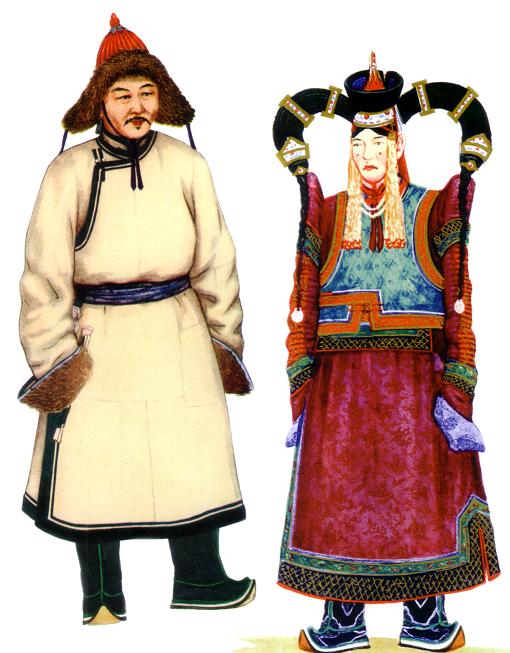
Mongolian Ethnic
Mongolian Ethnic - Unique type of nation
Although most people probably think of Mongolia as being inhabited by a single ethnic group - the Mongols - this is wrong. There are actually quite a few. There are over 20 different groups of Mongols.
Ethnic group, Percentage of total population:
Khalkh (Халх) - 84.5%
Kazakh (Казах) - 3.9%
Dörvöd (Дєрвєд) - 2.4%
Bayad (Баяд) - 1.7%
Buriad (Буриад) - 1.3%
Dariganga (Дариганга) - 0.9%
Zakhchin (Захчин) 1.0%
Uriankhai (Урианхай) - 0.8%
Khalkh
The Khalkh are the largest group of Mongols in Mongolia. In fact, they are the core of all the Mongol peoples across North Asia. The Khalkha Mongols are considered the direct descendants of Chinggis Khan and therefore, the true preservers of Mongol culture.

Khalkh Mongol Costume
In the thirteenth century, Chinggis Khan formed one of the greatest empires in world history by uniting all of the nomadic Mongol tribes. The Khalkha Mongol language, Halh, is the main Mongolian language, since all other Mongols speak variations or dialects of Halh. Halh is understood throughout Mongolia and by Mongols living in Central Asia.
Kazakh
The Kazakh of Mongolia belong to a larger group of people who live primarily in Kazakstan. Ethnically, they are of Turkic descent, and are the second largest Muslim group of Central Asia.
The Kazakh developed a distinct ethnic identity in the late fifteenth and early sixteenth centuries. In the nineteenth century, the Russians acquired Central Asia through a steady process of annexation.
The Kazak who now live in Mongolia make up the largest non-Mongolian ethnic group in the country. At the present time, their number is decreasing since many are emigrating back to their homeland, Kazakstan.
Dorvod
The Durbet are a Western Mongol tribe. They are primarily located in the western part of Mongolia, near the border of Russia. In the early 1600's, most of their ancestors (the Oirat) left their homeland, Dzhungaria, which is now part of the Xinjiang region of China, in hopes of settling in the rich pastures of the northern Caucasus Mountains.
In 1771, the majority of the Oirat decided to move back to Dzhungaria in order to escape the Russian dictatorship. Those who stayed in Russia became known as the Kalmyk, which means "to remain." Of those who left Russia, only a small group survived the long and difficult journey back to Dzhungaria.
Having arrived in the land of their ancestors, the surviving Oirat were accepted under Manchu rule and given pastures for grazing their herds. Their descendants are still found in western Mongolia.
Bayad
The Bayad people are one of the Mongol tribes, residing in western Mongolia. In the 13th century the term "Mongol" grew into an umbrella term for a large group of tribes united under the rule of Chinggis Khan.
Ethnic distinctions among the Mongol subgroups are relatively minor. Tribal differences are usually not a political or social issue as the Mongols are a generally peaceful nation.
Buriat
The Northern Mongolians, also known as the Buryat, are believed to be the descendants of the western Mongols and the northern Siberians. They primarily inhabit the forested lowland regions along the Russia-Mongolia border. The territory that once belonged to the Northern Mongolian's ancestors includes the regions along Lake Baikal, which is located in present-day Siberia.

Buriat Costume
Three quarters of all Northern Mongolians still live there, in a region that is now known as the Buriat Autonomous Republic.
The Northern Mongolians are very similar to the Khalkha Mongols, particularly in their physical features, dialects, and customs. In fact, they are often indistinguishable from neighboring Mongol tribes. However, they maintain a number of small differences, the most significant of which is their language.
Dariganga
The Dariganga, a small people group of Mongolian origin, inhabit the southeastern regions of Mongolia. They are primarily located in the southern part of the Sühbaatar province, on a volcanic plateau near the Gobi Desert. The Dariganga belong to the eastern group of Mongols, which includes the Khalkha Mongols, the Buryat, and most of the Chinese Mongols.
The Dariganga language is closely related to Halh, and is often referred to as a Mongolian dialect. However, all Dariganga are also able to use Halh in conversation with other Mongols in North and Central Asia.
Zakhchin
The religion of the early residents of the Mongolian region recognized only one uniform godly power, localized in the celestial vault. They also worshiped certain natural phenomenon, and believed in a life after death in the form of spirits (demons).
The artwork of the people, their great poetic talents, their epic works and the lyric poetry are outstanding. Singers and poets used to walk from camp to camp, singing their songs and epics, reflecting the expression of freedom and the immensity of the Mongolian steppes.
Uriankhai

Uriankhai Costume
The Tuvinian in Mongoloia inhabit a harsh mountainous region in the northern part of the country, near the border of Russia. There, the summers are hot and dry, while the winters are bitterly cold. Still, this region can have as many as 300 sunny days a year, and the extremely dry air helps people to withstand the cold winters and the hot summers.
Because the Tuvinian, like other Russian settlers, left their home territories in the Soviet Union many years ago and immigrated to Mongolia; their present "national" status is disputed. Some Tuvinian clans in Mongolia have maintained their native language, ethnic background, and traditional culture.
Other Tuvinian clans have been absorbed by the Mongolian culture. Their original language, Tuvin, contains many Mongolian words and uses the Cyrillic script. Most Mongolian Tuvinian also speak Halh, the national language of Mongolia.













